How urgent action to protect nature now will shield us from growing climate tipping points
Johan Rockström
This post first appeared on Reuters.
The incredible human development over the last 10,000 years was founded on a relatively stable climate system. But now that stability is under threat more than ever. We are already at 1.2 degrees Celsius hotter than pre-industrial levels, and without immediate action face a 50-50 chance of planetary warming surpassing 1.5C in the next five years.
In September, myself and colleagues published a study showing that this rapid warming is unleashing climate tipping points – when massive parts of the climate system, which have remained stable since the dawn of civilisation, pass a point of no return and irreversibly change state.
Ten years back, we saw tipping points as low-risk but high-impact events, which were only likely if the temperature reaches 3C or more later this century. But now, with more scientific understanding of interactions and self-reinforcing feedbacks, together with changes in the Earth system occurring faster than predicted, they are an increasingly present threat. In fact, our conclusion today is that four of the 15 known climate tipping element systems are likely to cross tipping points at 1.5C of warming. These include decisive systems for people and planet; the Greenland ice sheet, the west Antarctic ice sheet, tropical coral reef systems, and abrupt thawing of boreal permafrost.
Just as the science reveals with stark clarity the scale of the problem, we also now understand the solutions.
We know that emissions must halve every decade from now to 2050. This exponential halving is established as a universal benchmark: a “carbon law” that applies to business and cities as well as countries. Renewable energy systems that replace oil, coal and gas are today available, economically competitive and scalable in most economies in the world. Fossil-fuel free solutions are available for difficult-to-abate sectors such as cement and steel. Circular business models are possible to move beyond pilot scale, if combined with the right policies for material reuse and recycling.
But halving greenhouse gas emissions from energy, industry and transport will not be enough. To stabilise global temperatures, we need natural climate solutions that turn working lands – farms, grazing pastures and forests – from amongst the highest emitters of greenhouse gases into enormous carbon stores. We need a carbon law for nature, and a path to get there.
In September, Conservation International published an “exponential roadmap” for natural climate solutions. It charts, for the first time, how a rapid change in land management, protection and restoration of healthy ecosystems can turn a problem into a solution this decade.
Stabilising temperature close to 1.5C means that emissions from land must not only reach net zero by 2030, moving from 12.5 gigatonnes (Gt) of greenhouse gas emissions from land each year currently, but be followed by a 5Gt sink by 2040 and a 10Gt sink by 2050.
We all have a role to play to make this happen. While governments need to provide leadership and direction, businesses must act at speed and scale. Three things must happen, urgently.
First, all companies with supply chains dependent on sourcing from land or ocean must adapt their business models to be in line with a net-zero world. This starts with the carbon law for fossil fuels, and to this is added the carbon law for nature. Setting net-zero targets for both fossil fuels and nature is necessary to align business with the scientific assessment of what is required to hold the 1.5C line. Managed nature, ie agriculture, contributes 22% of global emissions, and fully half of that comes from deforestation and land conversion to grow food, fibres and fuel. Business must set net-zero targets with annual or even monthly targets.
Second, these companies need to create nature-positive supply chains. That means sourcing forest and food commodities that are produced using regenerative agriculture and sustainable forestry practices that deliver positive outcomes for people, nature and climate.
Third, we need to develop high-integrity carbon credits that allow businesses to invest in nature and climate solutions in addition to their phase out of fossil-fuel emissions. There is no room for offsetting between carbon law reductions and nature investments: both are needed with full force, simultaneously.
This is the only way to make businesses truly net-zero, and in due course even net-negative, in other words absorbing more carbon than they emit, which is necessary in order to meet the scientific targets.
Key in all this is that nature-based solutions must recognise the legitimate domestic interests of developing countries, including smallholders, indigenous peoples and local communities.
All these elements need to be underpinned by robust and transparent reporting.
Meanwhile, governments, multilateral institutions and development banks, with banks, investors and business, must help address the massive finance gap for nature ahead of the COP27 climate summit in November.
Averting the growing climate crisis is still possible, but only by harnessing the power of nature alongside rapid emissions reductions. Businesses large and small have an opportunity to be part of the solutions, safeguarding not only their own future, but that of the planet.
We must now do everything within our power to keep the temperature as low as possible because every 10th of a degree matters. Time is not on our side, and we need the entire world to act together at an exponential pace. This urgency requires massive efforts to dramatically reduce greenhouse gas emissions and manage, restore and protect nature and farmlands – starting immediately. The biggest effort needs to happen now, this decade. Governments need to guide a stable transformation of societies. Consumers need support and guidance to change their lifestyles, which will improve people’s lives in many ways. And, of course, businesses need to lead the way and drive the change.

